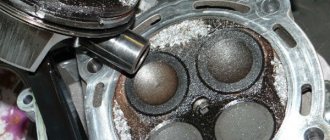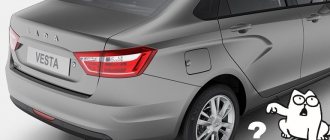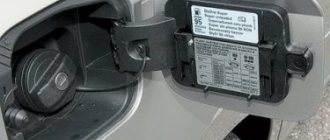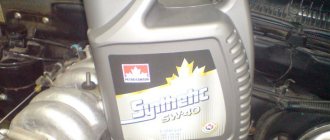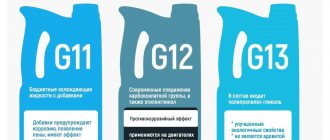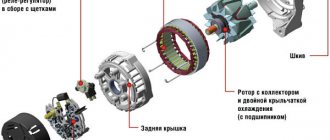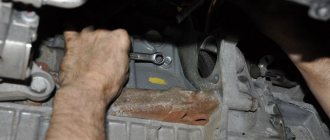Ignition module
The appearance of microcracks in the ignition module housing is a common occurrence. Poor quality plastic, which shrinks under the influence of temperatures, leads to the appearance of cracks. Insufficient spark power reaching the wires, and then to the spark plugs, leads to the problem of improper ignition of the mixture. In case of such a malfunction, the check also lights up.
You should not try to glue microcracks, because... they will appear again when exposed to temperature. Replace the ignition module and reset the errors. If there are breakdowns, check the condition of the wiring to the module and the condition of the chip.
A malfunction of the module not only causes high gas consumption, but also leads to “tweaking” of the engine, which can lead to rapid wear. Malfunctions in the spark supply system conceal a lot of problems: decreased dynamics, the appearance of lumbago, contamination of the combustion chamber of the mixture due to the lack of a spark, etc.
Engine 1.6 model 21126
In 2010, the popular 1.6 engine with sixteen valves was modified, as a result of which it began to produce 98 horsepower, accelerating the car to 190 km/h, and to the first hundred in 11.2 seconds. Gasoline consumption of this modification:
- heavy traffic 9.5 l;
- mixed cycle 7 l;
- highway 5.4 l.
Real consumption
- Igor, Moscow. A universal option for city and country trips. The 1.6 engine with a manual transmission is very reliable, responsive and unpretentious. Measurements showed that the consumption practically corresponds to the passport value. On the highway, 5.5 liters of AI 95 are consumed per 100 kilometers; in the city, even in winter, no more than 10.
- Yaroslav, Kharkov. I consider the VAZ 2114 one of the most successful cars, but it requires timely maintenance, especially the 1.6 engine with 98 horses. The transmission and chassis are very reliable, consumption does not exceed 9 liters, in a circle it turns out to be about 7 liters per hundred.
- Stepan, Kazan. I bought a new car in 2010 with a 1.6 engine. Initially, I was worried about the consumption - in the city it reached 12 liters, I was looking for the reasons for the high fuel consumption in my VAZ 2114, but after the run-in everything fell into place: 9 in traffic jams and 6 on the free road, even if driving energetically. Comfort is a little weak, but otherwise a very good car - reliable, dynamic, inexpensive to maintain.
- Ivan, Ryazan. I bought a VAZ 2114 in 2010, during which time I can say that the money was well spent. The car pulls excellently, it is reliable and easily digests 92-octane gasoline. The suspension is ideally adapted for our roads, the mechanics do not cause any complaints. Consumption is also pleasing - in the urban cycle it does not exceed 10 liters, and on the highway you can easily keep it to 6.
- Boris, Smolensk. I often travel to Minsk for work, so I need a reliable and economical car. The VAZ 2114 with a 1.6 engine producing 98 horsepower met these criteria, and for quite reasonable money. Fuel consumption on the highway is about 6 liters, I drive around the city less often, here you will need up to 9 liters per hundred.
Advice from motorists
Often, car owners try to listen to the advice of other drivers, including on the issue of how to refuel a VAZ 2114. True, the advice here is radically different - one half drives a 92 and praises it, the other is in favor of a 95, because that’s what’s written in the passport and this is right".
In such a situation, it is worth recalling the above phrase once again - a difference of 3 octane units is quite insignificant and is poorly perceived by both the car and its driver (in the latter case, most opinions like “better are subjective”). An objective assessment here could be fuel consumption or the degree of wear of some elements, but they are almost the same (of course, there is a difference, but it is very small).
Mass air flow sensor (MAF)
The most expensive sensor in the “four” is the mass air flow sensor. It is very sensitive to dirt and oil. Untimely replacement of the air filter and wear of the piston group lead to contamination of the mesh of the mass air flow sensor. A faulty sensor gives incorrect readings about the amount of air consumed and prevents the computer from forming the mixture normally. This increases fuel consumption. The check on the dashboard may not indicate a problem.
A malfunctioning mass air flow sensor is a serious problem. With this problem, there are failures in acceleration, engine shutdown after engaging neutral gear, and constant “floating” of revolutions. To correct the situation, you can clean the mass flow sensor housing and the mesh using chemicals. Before purchasing a new mass air flow sensor, confirm that the old one is faulty with a multimeter. The price of a new spare part is about 3 thousand rubles.
A few words about American and turbocharged engines
I was also bombarded with the following questions: “I bought a car imported from the USA, it says that you need to use AKI 91 gasoline. What is this, and what kind of fuel should I choose?”
The US market has slightly different standards; their classification is not like ours (that is, “research”). The abbreviation AKI means a conditional, average designation of two indices ((“research” + “motor”)/2).
If we bring it closer to our standards, we get something like this:
AKI87 = AI92
AKI89-91 = AI95
AKI93 = AI98
I would also like to note the turbocharged options; in the last article I said that it is recommended to use at least “95” in them.
Let's think logically, why 95 and 98? Turbocharged engines use much larger volumes of air and fuel, the mixture in them must be richer, and from the points above we understood what ENRICHED fuel is, it gives us more octane. Think for yourself - WHY BUY A TURBO, AND FURTHER FEED IT WITH LEAN MICHES, it’s just not designed for that! The amount of air must strictly correspond to the caloric content of the fuel.
It is also worth noting that when using the “92”, as many manufacturers indicate, the “required temperature regime” may be violated, which may lead to the failure of some components, in particular the “turbine” itself.
Therefore, in TURBO, only “what the doctor ordered”, otherwise it is fraught with repairs
Didn't find the information you are looking for? on our forum.
We recommend reading:
How much oil is in a box of VAZ 2114 8 valves
How to check gasoline consumption. The easiest way
Why can't you fill up a full tank of gas? Main reasons
VAZ 232900
Motor oil liqui moly synthoil high tech 5w40 4l, characteristics
Idemitsu 10w 40 engine oil, reviews, specifications
Gasoline gets in your eyes, what to do, consequences
Longlife 98 engine oil
Good gasoline - from a good gas station
It is probably no secret that many gas stations supply motorists with low-quality gasoline - diluted, with a low octane number, or simply lost in quality due to improper storage and transportation (when gasoline is poured into containers that have not been cleaned after other petroleum products). Situations like this are not uncommon these days and are common throughout the country.
Sometimes, even at two neighboring gas stations, the quality of gasoline of the same brand can be radically different. This is what every motorist should pay attention to - having visited several gas stations in your place of residence, and having found the best one, you should use only its services (of course, only if the quality of gasoline at this gas station does not drop sharply).
To once again prove the importance of choosing the right gas station, and not the right brand of fuel, we can give examples of octane number measurements at different gas stations: in less than half of the gas stations studied, 95th gasoline turned out to be really 95th. With 92, the situation is a little better, but not much (in general, according to statistics, the more expensive gasoline is, the more often it is counterfeited/diluted).
That is why it is much more important to choose a reliable fuel supply company and use only its services than to believe the numbers written on any random gas pump.
Experts poured AI-100 into a Lada engine and were surprised by the result
By the end of the year, Gazpromneft will refuse to sell 98-grade gasoline. At the pumps where it is currently available (400 gas stations throughout the country), it will be possible to buy AI-100.
– For three years, the “hundredth” G-Drive has been sold at our stations in Eastern Europe, where it has gained great popularity. We are glad that now Russian motorists will be able to appreciate this high-tech fuel, feel the full power of their car and get maximum driving pleasure,” the Gazpromneft gas station network commented on the news.
We are also glad that drivers in Eastern Europe appreciate domestic gasoline. But half of Russia drives Ladas of different vintages. Will high-octane gasoline benefit ordinary drivers?
The answer to this question was obtained in the laboratory of South Ural State University. Experts tested G-Drive 100 gasoline on a VAZ-21114 engine (installed on VAZ 2110, 2111, 2112 models). Almost a third of the country’s entire passenger car fleet now drives with such engines.
What we found out:
– AI-100 does not harm the “tens” engine in any way.
– Detonation does not occur even at the highest speeds.
– Burnout of valves was not noticed.
– “100th” gasoline reduced fuel consumption (compared to AI-95) in all engine operating modes.
– Almost no carbon deposits are formed.
Pavel Kartashov, technical expert of the international company APL, commented on the results obtained.
– Each driver experiences driving modes when the likelihood of detonation is increased: lifting, acceleration, and so on. Under these conditions, high-octane gasoline will allow the engine to run more smoothly. Detonation either will not occur or will appear later. And one more thing: all engines have deposits in the combustion chamber; they appear after 15-25 thousand kilometers. Deposits change the combustion conditions of gasoline and contribute to detonation.
Kartashov explained that deposits interfere with heat transfer through the walls of the engine. Because of this, the combustible mixture in the cylinder heats up more, and this already leads to detonation.
“On used engines, it is recommended to use gasoline with an octane number increased by 3-5 units or more,” the expert added.
And yet, for which vehicles is the AI-100 suitable?
For everyone who has no upper octane limit. If it says: no less than 92 or 95, then you can safely say “hundredth”. The engine will only be better for it.
But if the manual clearly states: from 92 to 95, then high-octane fuel will not work.
G-Drive 100 gasoline is produced at the country's largest oil refinery in Russia in Omsk (owned by Gazprom Neft). After modernizing the installations, refineries can directly produce “100th” fuel. It does not contain any octane-boosting additives, which means AI-100 is safe for cars.
Now “100th” gasoline is transported by rail from Omsk to the country’s oil depots. From there they are delivered on fuel trucks to the gas stations of the Gazprom Neft network.
WHAT IS DETONATION AND OCTANE?
The octane number shows the ability of gasoline to resist detonation. With proper combustion of fuel, the flame front moves along the cylinder from the spark plug at a speed of 30-60 m/s. Everything develops smoothly, calmly, predictably.
But if somewhere (usually in the part of the combustion chamber farthest from the spark plug) explosive self-ignition of the fuel occurs, then a detonation wave rushes towards the normal flame front. Its speed can exceed 330 m/s.
For an engine, such abnormal explosions in the cylinder can be disastrous - detonation leads to burnout of valves, destruction of pistons, and the appearance of scoring on bearing liners.
Pavel Kartashov, technical expert of the international company APL:
“The first gasoline with an octane number of 100 appeared during the Second World War,” said Pavel Kartashov. – Further, the development of automotive technology and the development of oil refining technologies went parallel to each other. As a result, engines with high compression ratios appeared, which required high-octane gasoline. High-octane gasolines are currently used for cars with powerful turbocharged engines, for cars with a high compression ratio. But even the most ordinary modern car is increasingly calibrated for high-octane fuel, so the consumption of high-octane gasoline is growing more and more.
Useful video
You can glean additional useful information from the video below:
Sources
- https://RasxodTopliva.ru/45-vaz-2114.html
- https://pobenzinu.ru/benzin/rashod-vaz-2114
- https://AvtoZhor.com/vaz-2114-rasxod-topliva/
- https://www.vazzz.ru/rashod-benzina-vaz-2114-trassa-gorod-smeshannyj-tsikl/
- https://avto-kul.ru/ekspluatatsiya-avtomobilya/rashod-topliva-vaz-2114.html
- https://remontvazov.com/vaz-2114-rashod-topliva-na-100-km
Summarize
And so, taking into account the above, we can say with complete confidence that it makes no difference what kind of gasoline to fill the VAZ 2114 with - 95 or 92. After all, both in terms of fuel consumption and the effect on the wear of machine parts, both of these brands perform almost identically.
If it is possible to actually fill the car with 95 (and this is proven by measurements, and not by the name of gasoline at the gas station), then it is better to fill it in the summer or when driving outside the city. And 92nd, in turn, should be filled in in winter or during city trips.
Sixteen-valve engine 1.6 model 21124
Developing the line of successful 1.6 engines, in 2009 a 16-valve modification 21124 with direct injection and manual transmission was offered. This power unit develops 90 horsepower, accelerates the car to 100 km/h in 11.2 seconds, with a maximum speed of 185 km/h. At the same time, fuel consumption 2114 per 100 km became lower:
- city mode 8.2 l;
- average 7.6 l;
- on a free road 7.2 liters.
Feedback data
- Vladimir, Velikie Luki. My VAZ 2114 2010 with a sixteen-valve 1.6 with 90 horsepower for a taxi. I made no mistake in my choice - a reliable, roomy, economical car with measured driving. During this time, the chassis had to be repaired more than once, but the engine performed well, and didn’t even start taking oil. Even in winter, consumption does not exceed 9.5 liters, on the highway at 110-120 km/h about 6 liters, you start driving more, your appetite increases abruptly. At one time, the fuel consumption on my VAZ 2114 increased, but after checking the condition of the injectors and cleaning them, everything was restored.
- Alexey, Vologda. I learned on this car, I borrowed it from my father. I've driven more than 90 thousand km - it's a very good car, the 1.6 engine with 90 horsepower is unpretentious and reliable, it pulls well. It holds the road well, but feels good on the ground and on city streets. Fuel consumption per hundred is from 9 to 7 liters.
- Nikolay, Kaluga. I have owned the car for more than 10 years, and I consider it a good option for a family with two children. A universal option for trips to the shops, to school, to nature or to the countryside. I drive carefully, so on the highway the gasoline consumption is 5.5 liters, in traffic it increases to 8 liters, which suits me quite well, and I’m not going to change my VAZ 2114 yet.
- Anatoly, Omsk. I needed an unpretentious car, an option that was cheap to maintain and repair. VAZ 2114 with a 1.6 engine with 90 horsepower fully satisfied my needs. Fast and passable, there have been no serious problems the entire time, at speeds above 120 km/h the consumption is about 8 liters, but in economy mode you can keep within 5 liters.
- Denis, Perm. The 2114 is very popular with us; I bought a used car for driving out of town, hunting and fishing. I installed all-season tires, now the car is not afraid of dirt and potholes. The suspension is elastic and reliable, there were no problems with the gearbox. Timely replacement of filters and oil guarantees the reliability of the 1.6 sixteen-valve engine, consumption in heavy traffic is up to 9 liters, and on the highway 7.
Is it possible to fill up with 95 gasoline if I drive on 92?
Is it possible to fill up with 95 gasoline if I drive on 92? Now I will have to drive about 380 km along the highway there and back during the night. Is it possible to fill up with 95 gasoline if I always drive on 92. Well, the same about 98 or 92 pulsar and others. VAZ 2114 8kl 1.5l. And will this make any sense other than overpaying for fuel?
There won’t be anything worthwhile about the cream of overpayment right now, gasoline is just crap, it makes no difference that 92 or 95 is one dick, both of them are bad and their actane numbers do not correspond to their brand, it’s 100% I fill up at Rosneft, having tried to fill up with 95 it’s even worse ((( and smoke the black one came from Glushak
You can fill in at least 98 and nothing will happen. But I advise you to switch the stock engine to 95 and drive it constantly. The difference in price is not so great, but in the end you will understand that driving a 95 is cheaper than driving a 92
Replacement frequency. Influencing factors
First, the oil change in the VAZ 2114 engine is carried out based on the mileage that the car has traveled. Each car owner decides for himself when it is time to change the lubricant. But the experience of the owners of the fourteenth model, as well as the advice of professionals, gives a hint that it is better to change the oil approximately every 10-15
Removing the oil filter
There are a number of reasons that can affect the frequency of replacement:
- Current condition of the car;
- Engine wear level;
- The quality of the previously used lubricant for the unit;
- Conditions in which the vehicle is operated;
- Seasonality of car operation;
- Driving style.
What happens in the gas tank
It is for this reason that car enthusiasts like to fill their gas tank with equal amounts of both types of fuel, because they believe that they have managed to combine a low price, good engine response, and all this on relatively pure gasoline. However, different grades mean not only different octane numbers, but also different fuel densities. Knowledge of the simplest laws of physics tells us that the denser and heavier 92- will sit at the bottom of the fuel tank. At the same time, the lighter 95 will tend to move up. Hence the conclusion:
Both fuels will be consumed alternately, with little actual mixing occurring.
If this is so, then it is unlikely that it will be possible to achieve a particularly significant improvement in the characteristics of the power unit. On the other hand, we can talk about small savings, which are unlikely to exceed a few percent. But for particularly scrupulous drivers, this may be important, because instead of pure 95, we partially fill it with fuel with a lower octane number.
Lambda probe
The oxygen sensor in 2114 is an unreliable element. Its malfunction affects the stability of the engine. When the lambda probe breaks down, the engine at idle starts to work with dips. Its malfunction is first indicated by a check on the dashboard. The built-in self-diagnostic function also allows you to determine the error code. Replacing the lambda probe is done by yourself. You can continue driving if it breaks down, but this will increase consumption.
Which coolant to choose
Every motorist who wants to replace the entire coolant in the car system is interested in what kind of antifreeze to pour into the VAZ 2114? And which one is better not to buy? First of all, it’s worth saying that there are now a very large number of counterfeit coolants on the market, which can be easily recognized by poor-quality packaging and labels. In addition, you should always carefully read the name, which should indicate the category of the liquid.
As for brands and manufacturers, preference should be given to the following:
- CoolStream Standard – G11, green;
- CoolStream Premium – G12, orange;
- Lada Concentrate - category G11, produced either by Oil Center (Tolyatti) or Bulgar Lada Plus (Kazan);
- Lada A-40 - similar to Lada Concentrate, but supplied ready-to-use;
- OZH-65 TOSOL-TS - classic antifreeze, produced in the city of Dzerzhinsk;
- OZH-65 TOSOL-TORSA – G11, blue-green color;
- “Antifreeze G-48” – slightly green, G11. Previously produced in Perm, now rare.
Complex terminology in simple words
And in order to understand something, you will have to operate with certain terms that are closely related to internal combustion engines and the fuel for them. Unfortunately, in most sources of knowledge these very terms are presented too cleverly. Therefore, let's start by getting acquainted with the terms we need in a language that is simple and understandable to most.
Octane number
Octane number is a characteristic of gasoline, which means its resistance to self-ignition due to pressure. The higher this number, the more pressure gasoline can withstand without igniting.
This is important because in gasoline internal combustion engines, the fuel must be ignited solely by a spark. If the resistance to self-ignition turns out to be insufficient, then the gasoline compressed by the piston simply “will not wait” for that very spark and will begin to burn earlier than necessary
Detonation
Detonation is nothing more than the spontaneous ignition of gasoline that “did not receive its spark.” The user can clearly perceive this effect by ear. Fuel detonation is heard as a metallic knocking or ringing sound, sometimes identified as “knuckle tapping.” In reality, no fingers are tapping there. These are sound waves that arise as a result of a sharp increase in pressure in the combustion chamber at the moment of self-ignition of gasoline with an insufficiently high octane number.
Needless to say, detonation has a detrimental effect on engine life. Little of. Self-ignition contributes to a decrease in engine efficiency and power, accelerates wear of piston group parts, and can even lead to destruction of structural integrity.
Knock resistance
The knock resistance of gasoline is a parameter that indicates its ability to “tolerate” compression in the cylinder, that is, not to ignite before it should. It just depends on the octane number. The higher it is, the higher the detonation resistance. That is, roughly speaking, 95 gasoline can be compressed more than 92 gasoline.
Compression ratio
The compression ratio is an engine characteristic that indicates the ratio of the total volume of the cylinder to the volume of the combustion chamber. If anyone doesn’t know, the total volume of the cylinder is the space that forms above the piston at the moment when it is at the so-called bottom dead center. And the volume of the combustion chamber is the space that remains above the cylinder of the total volume at the moment when the piston is at top dead center.
In simple terms, the higher the compression ratio, the more the air-fuel mixture is compressed when the piston approaches top dead center. Accordingly, the higher this characteristic is, the greater the pressure on the mixture. This means, in turn, that the higher the engine’s compression ratio, the greater the fuel’s knock resistance. That is, it must have a higher octane number.
Compression
Compression is the pressure that is created in the combustion chamber at the moment when the piston is at top dead center. That is, it turns out that the greater the compression, the higher the pressure. This means that with increasing compression, the detonation resistance of gasoline, which is used in this case, should also increase.
Despite this, the octane number of gasoline is never tied to engine compression, as was described for the compression ratio. This happens because the manufacturer, recommending the use of this or that gasoline for a particular engine, implies that it will be operated only with acceptable compression. And after it decreases as a result of wear, repairs will be made.
Although in theory, when compression decreases, the pressure with which the air-fuel mixture is compressed in the combustion chamber also decreases. Accordingly, the requirements for detonation resistance can also be relaxed. As a result, it turns out that with a decrease in compression in an engine designed for 95 gasoline, 92 gasoline will also be able to operate without self-ignition.
Thanks Don't like it
Pachim? Theoretically, gasoline is different. And there should be a difference. I won’t say that it flies at 95m, but it’s definitely quieter and smoother.
Because all factory firmware is written with a “reserve” for fuel. Nominally in the manual the factory writes that it should pour 95, but it is envisaged that the user will pour something worse into it and the car should go. Therefore, the values of SOP and detonation rebounds in the firmware correspond to the 92nd bezine. And all the factory firmware is like this, well, this is the reality of our country, that the plant is forced to protect itself, because in our vast territory there is a good 95, to put it mildly, not everywhere. But at the cost of some deterioration in power and economic indicators. Therefore, if we take normal 92 and 95, then the difference at the drain is at the placebo level. Theoretically, it cannot exist. If you have the opportunity to pour a good 95 in a proven place, then you can slightly correct the firmware and get some real increase in power and driving efficiency. But 92 then excuse me. Post edited by StrayCat: August 26, 2011 - 01:50
Throttle Position Sensor (TPS)
The TPS is responsible for determining the angle at which the damper is rotated. The power consumption, engine power, and dynamic characteristics of the car depend on this. Correct mixture formation is also impossible without correct indications from the TPS. Symptoms of its malfunction are floating speed, dips and jerks during acceleration, and the appearance of a “check” on the dashboard.
